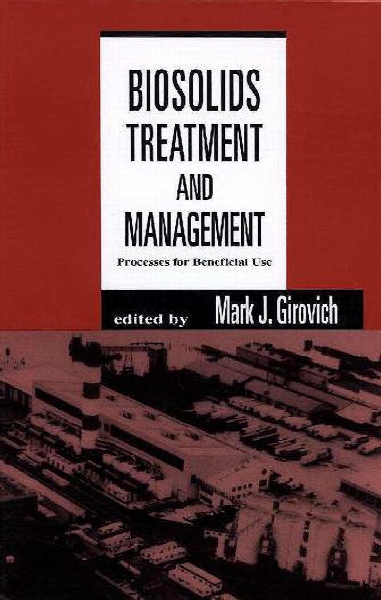Biosolids treatment and management : processes for beneficial use
- نوع فایل : کتاب
- زبان : انگلیسی
- مؤلف : Mark Ja Girovič
- ناشر : New York, NY [u.a.] : Dekker
- چاپ و سال / کشور: 1996
- شابک / ISBN : 9780824797065
Description
Chapter 1 Biosolidr Characterization, Treatment and Use: An Overview Mark J. Girovich I. Biosolids Generation and Beneficial Use II. Biosolids Characterization A. Composition and Beneficial Properties B. Microbiology of Biosolids C. Odors and Other Nuisances D. Other Characteristics III. Biosolids Treatment for Beneficial Use: An Overview A. Beneficial Uses B. Requirements for Beneficial Use C. Treatment Processes: An Overview References Chapter 2 Federal Regulatory Requirements Jane B. Forste I. Historical Backpound and Risk Assessment A. Inimxluction B. C. DataGathering D. Risk Assessment Methodology Basis for the 503 Regulations II. Final Part 503 Regulations A. Introduction B. Exposure Assessment Pathways C. Final Part 503 Standards iii xi 1 47 III. Pathogen and Vector Attraction Reduction References V vi Chapter 3 Conditioning and Dewatering Robert J. Kukenberger I. Sntroduction II. Conditioning A. Organic Polyelectrolytes B. C. Inorganic Chemical Conditioning D. Thermal Conditioning Polymer Feed and Control Systems III. Dewatering A. Process Description B. Thickening C. Mechanical Dewatering D. Passive Dewatering IV. Odor Control V. Casestudies References Chapter 4 Digestion Kenneth J. Snow I. Biosolicls Digestion A. Introduction B. Process Fundamentals C. Equipment Review D. Economics of Digestion n. casestudies References Chapter 5 Cornposting Lewis M. Naylor I. Introduction A. Growth of Cornposting in the United States Contents 13 1 165 193 II. Goals of cornposting A. ChemicalQuality B. Biological Quality C. Customer Requirements Contents vii HI. Process Fundamentals A. Microbial Community B. Environmental Conditions C. Nutritional Considerations IV. Solids and the Cornposting Process A. Types of Solids B. Particlesize V. Process Energetics A. The Biological Fire B. Heat and Temperature C. Temperature Control D. Aeration VI. Preparing a Blended Feedstock A. Dry Solids and Porosity B. Chemical Composition C. Ingredient Selection D. Developing a Blended Feedstock Recipe W. OdorRemoval A. OriginsofOdors B. Odor Control Technologies C. Biofilter Fundamentals and Operations D. Biofilter Challenges WI. Pre- and Post-Processing IX. Marketing A. Marketing Issues X. OutlookandSUmmq References Chapter 6 Heat Drying and Other Thermal Processes Mark J. Girovich I. BiosolidsDqmg A. B. Partially Dried Biosolids Heat Drying and Production of Fertilizer 271 II. Heat Drymg Processes viii Contents III. DryerDesigos A. DirectDryers B. IndirectDryers IV. Major Dryer Parametem A. Evaporation Capacity B. Energy and Dqmg Air Requirements V. HeatDrylngSystems A. System Components B. C. D. Ekonomics of Heat Drying Handling and Treatment of Drying and Heating MeCllUftl EnvLonmental Control and Regulatory Issues VI. Production of Fertilizer: Case Studies A. B. C. Baltimore City Fertilizer Facility Milwaukee Biosolids Dqmg and Pelletizing Plant New York City Biosolids Fertilizer Facility W. Other Thermal Processes A. Carver-Meld (C-G) Process B. Wet Oxidation (Zimpro Process) References Chapter 7 Alkaline Stabilization Mark J. Girovich I. Introduction II. Alkaline Stabilization A. Pre-Lime and Post-Lime Stabilization B. Process Fundamentals C. Alkaline Materials III. Proprietary Alkaline Stabilization Processes A. BIO*FIX Process B. N-Viro Soil Process C. RDP En-Vessel Pasteurization D. ChemfixProcess E. Other Alkaline Stabilization Processes 343 IV. Economics of Alkaline Stabilization References contents Chapter 8 Land Application Jane B. Forste I. Introduction A. Historical Background II. Beneficial Properhes of Biosolids A. Nitrogen Considerations €3. C. Effects of Organic Matter from Biosolids on Soil Properties Effects of Other Biosolids Constituents III. Site Selection, Design and Management A. Site Selection B. Nitrogen-Based Agronomic Rates C. Design for Non-Agricultural Sites D. E. Agronomic Considerations Pathogen Considerations in Land Application Projects IV. Methods and Equipment A. Transportation V. Economics of Land Application VI. Monitoring and Recordkeeping A. B. Pathogen Reduction C. Vector Attraction Reduction D. Management Practices E. Monitoring General Requirements of 40 CFR 503.12 ix 389 W. Public Outreach A. Communication Channels References Index 449


